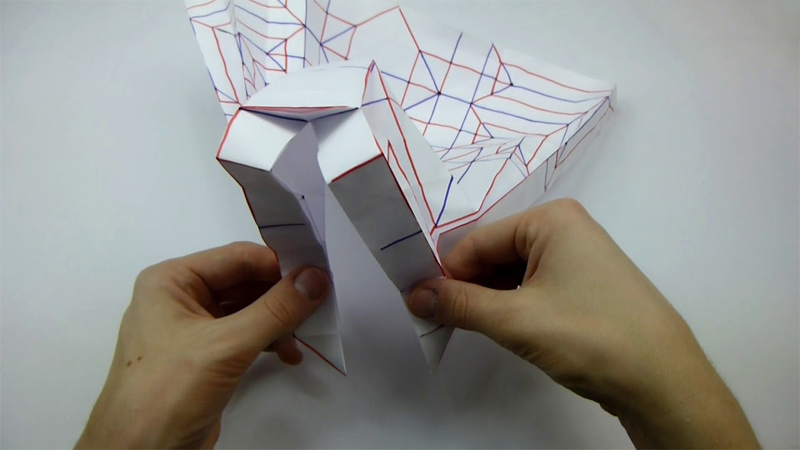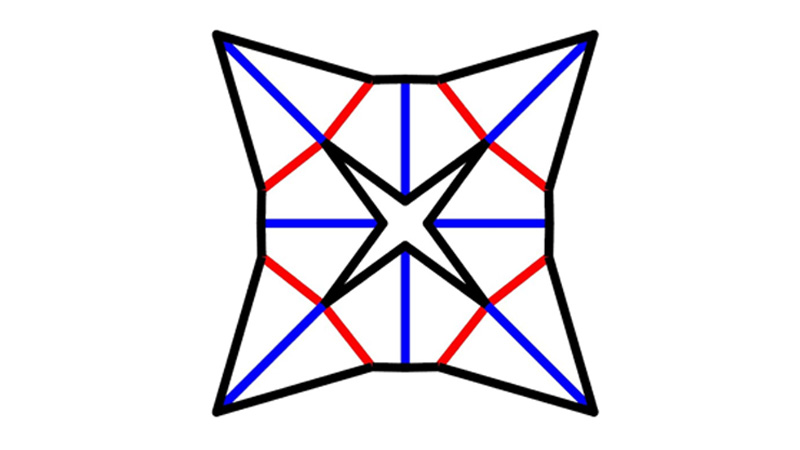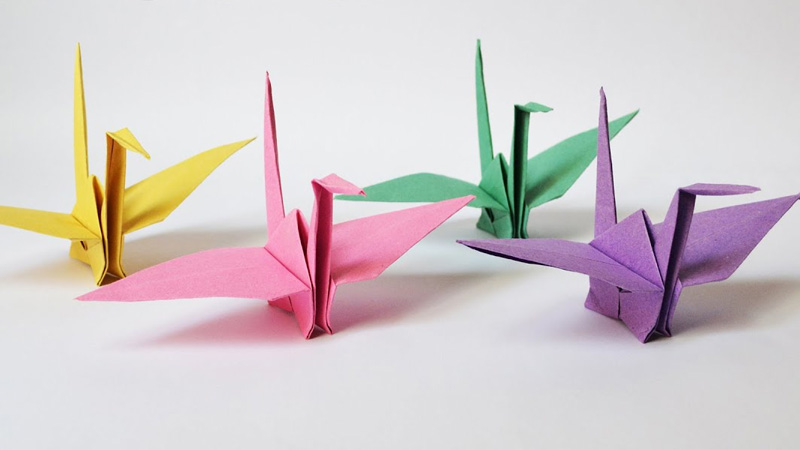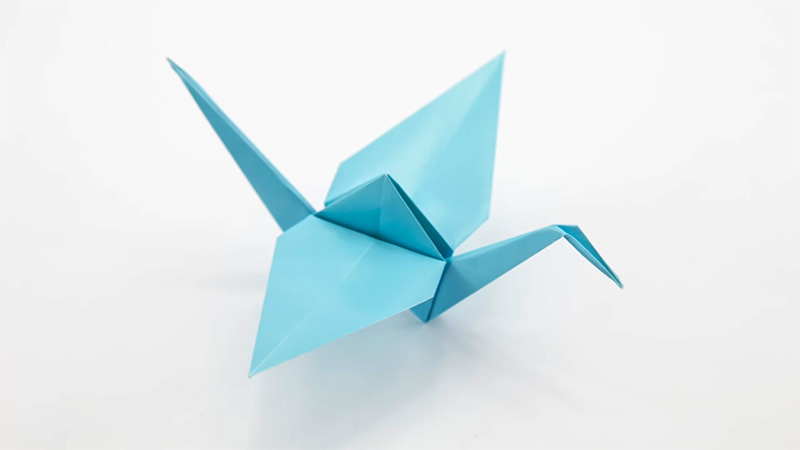Origami, the ancient Japanese art of paper folding, is a captivating craft that has transcended generations and cultures. Within this artistic realm lies a fascinating technique known as the “crease fold.”
At its core, a crease fold in origami involves precisely folding and aligning the paper along specific lines or creases to create intricate and precise shapes.
Unlike simpler folds, like the valley and mountain folds, which create basic geometric forms, crease folds unlock the potential for more complex and detailed origami designs.
These precise, strategic folds are the foundation upon which countless origami masterpieces are built, offering a gateway to a world of endless creativity and intricate paper sculptures.

What Is a Crease Fold Origami? -The Definition and Detail Aspects
A crease fold in origami is like a magical transformation that compresses hundreds of intricate creases and sometimes hours of meticulous folding into a single diagram.
It’s the fundamental technique that turns a flat, unfolded square sheet of paper into a complex and beautiful folded form.
This single act of precision, guided by the lines and symbols on the paper, is where art and mathematics converge, allowing artists to craft intricate sculptures and designs with nothing more than a square piece of paper and their creative vision.
Crease folds are the heartbeat of origami, where the unassuming paper comes to life in a symphony of folds, resulting in awe-inspiring creations.
Here’s a breakdown of what a crease fold in origami entails:
Folding Along a Line
In a crease fold, you fold the paper precisely along a designated line or crease. This line can be a dashed line (indicating a valley fold, where you fold the paper toward you) or a dotted line (indicating a mountain fold, where you fold the paper away from you). Solid lines often represent reference lines or other important points.
Accuracy Matters
What sets crease folds apart is the emphasis on accuracy and precision. Origami artists strive to make their creases sharp and exact, ensuring that the paper aligns perfectly with the intended shape.
Foundation for Complex Models
Crease folds serve as the building blocks for more complex origami models. By mastering this basic technique, origami enthusiasts can create intricate designs that range from animals and flowers to geometric patterns and modular structures.
Sequential Unfolding
In many origami diagrams, crease folds are typically depicted sequentially, showing the order in which they should be executed. Following this sequence is crucial to achieving the desired final form.
Versatility and Creativity
While crease folds are fundamental, they also provide room for creativity. Origami artists can experiment with variations in crease angles and shapes to add unique details and personal touches to their creations.
Origami’s Art and Science
Crease folds demonstrate the fusion of artistic expression and mathematical precision that defines origami.
The balance between aesthetics and geometry is what makes origami both a visual art form and an intellectual challenge.
Origami Crane Crease Patterns

Origami crane crease patterns are intricate diagrams that serve as blueprints for crafting the iconic paper crane.
These patterns are essential guides for origami enthusiasts looking to create this timeless symbol of hope and peace.
Each crease pattern meticulously outlines the precise folds and angles required to transform a simple sheet of paper into a graceful crane.
Beginners may find them intimidating, but experienced folders view crease patterns as a roadmap to perfection, allowing for a deeper understanding of the folding process and the ability to experiment with variations and complexities.
With practice and patience, origami crane crease patterns empower artists to craft elegant, three-dimensional cranes that embody both the art and the message of origami itself.
How to Read Crease Patterns

Reading crease patterns in origami may seem daunting at first, but with some practice and understanding, you can decipher these intricate diagrams to create beautiful paper models.
Here’s a step-by-step guide on how to read crease patterns:
Reading crease patterns in origami can initially seem daunting, but with practice and patience, you can decipher these intricate diagrams and transform them into beautiful paper sculptures. Here’s a step-by-step guide on how to read crease patterns:
Understand the Symbols
Crease patterns use a set of standard symbols to represent various types of folds and creases. Common symbols include dashed lines for valley folds (folding towards you), dotted lines for mountain folds (folding away from you), and solid lines for reference lines.
Study the Grid
Crease patterns are often presented on a grid, with horizontal and vertical lines. These lines indicate reference points and angles for your folds. Familiarize yourself with the grid to grasp the overall structure.
Identify Key Points
Crease patterns typically include numbered points or circles. These represent critical landmarks where you need to make specific folds. Start by finding these points on the diagram.
Follow the Lines
Trace the lines connecting the numbered points. These lines indicate the folding sequence. Valley folds, mountain folds, and other creases will be represented along these paths.
Mind the Angles
Pay attention to the angles and intersections where lines meet. These angles determine the precise folding angles. Use a protractor or ruler if necessary to ensure accuracy.
Practice Visualization
Crease patterns often don’t depict the paper’s physical appearance after each fold. You’ll need to visualize how the paper should look and align it accordingly.
Work Step by Step
Begin folding at the starting point (usually point 1), following the lines and making the specified folds. Gradually progress through the crease pattern, one step at a time.
Check Progress
After each fold, pause to check if the paper matches the crease pattern. Make adjustments as needed to achieve the correct shape.
Stay Patient
Crease patterns can be intricate and challenging, especially for complex origami models. Don’t be discouraged if it takes time to master reading and executing them.
Seek Help and Resources
If you’re struggling, consult instructional books, online tutorials, or origami forums where experienced folders may offer guidance and insights.
Popular Crease Fold Origami Models

Origami offers a vast array of models and designs, but some crease-fold origami models have gained popularity due to their elegance and cultural significance.
Here are a few well-known crease fold origami models:
Origami Crane (Tsuru)
The origami crane is perhaps the most iconic and widely recognized origami model. It symbolizes peace, hope, and longevity and is often folded to convey well wishes and healing.
Origami Butterfly
Butterflies are a favorite subject in origami due to their delicate beauty. Crease folds are used to create the intricate patterns on the wings, resulting in lifelike and captivating models.
Origami Frog
Crease-fold techniques are employed to craft playful and hopping origami frogs. They are popular for their simplicity and ability to jump when pressed.
Origami Dragon
While more complex, origami dragons are highly sought after for their intricate detailing and mythical allure. Crease folds play a crucial role in creating the dragon’s scales, wings, and other features.
Origami Flower Bouquets
Crease folds are essential in crafting various types of origami flowers, from roses to lilies. These models allow origami artists to explore a wide range of colors and forms.
Origami Samurai Helmet
Samurai helmets are a symbol of Japanese culture and history. Crease folds are used to create the helmet’s intricate design, making it a popular choice for origami enthusiasts interested in Japanese traditions.
Origami Star Boxes
Crease folds are used to create origami boxes with star-shaped tops. These boxes can be used for gift-giving or as decorative pieces.
Origami Fish
Fish have cultural significance in several countries, and origami fish are popular for their simplicity and symbolism. Crease folds create the characteristic fins and tails.
Origami Modular Designs
Some advanced origami enthusiasts enjoy creating complex modular designs using multiple folded units that interlock. Crease folds are essential in achieving the precision required for these intricate structures.
Origami Animals
Various animal models, including elephants, cats, dogs, and more, are popular choices in the origami world. Crease folds help capture the distinctive features of each animal.
FAQS
What is a crease fold origami for kids?
Crease-fold origami for kids is a simplified version of traditional origami, designed to be accessible and enjoyable for children.
What is a crease fold origami for beginners?
Crease fold origami for beginners is an introductory level of origami that focuses on basic folding techniques and simple designs.
Are crease folds reversible in origami?
Yes, crease folds in origami are typically reversible, meaning you can unfold the paper and return it to its original state without damage.
Can crease-fold origami be combined with other art forms?
Absolutely! Crease-fold origami can be integrated with other art forms like painting, drawing, or collage to create mixed-media artworks that blend paper folding with various creative techniques, adding depth and dimension to artistic projects.
To Recap
In origami, the crease fold stands as an essential and transformative technique. It is the very heartbeat of this ancient art form, where a simple sheet of paper becomes a canvas for intricate expression.
The precision and accuracy demanded by crease folds set the stage for origami’s delicate balance between artistry and mathematics.
Through these meticulous folds, artists embark on journeys of creativity and imagination, crafting diverse sculptures from graceful cranes to complex architectural wonders.
Crease folds, with their inherent challenge and boundless potential, exemplify the essence of origami itself a fusion of aesthetics and precision that continues to captivate and inspire generations of artisans worldwide.
Leave a Reply